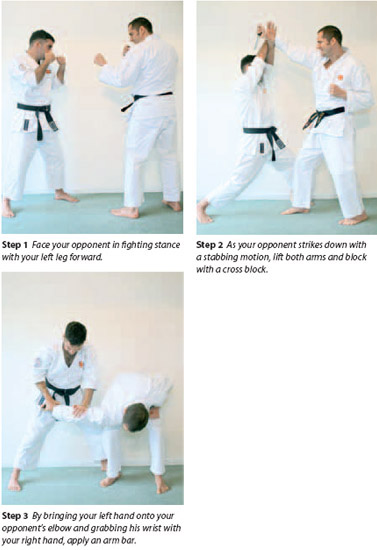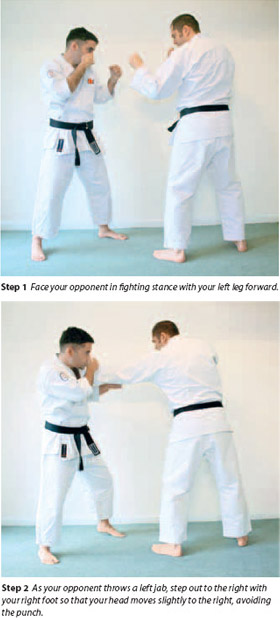
Of old the expert in battle would first make himself invincible and then wait for his enemy to expose his vulnerability.
~ Sun Tzu
Defenses
Having looked at a number of different strikes that can be made against you using the hands and elbows in the previous chapter, we now turn to a few different approaches to defending yourself. The most natural thing to do when defending yourself is to throw your arms out around your head to protect it. Training yourself in defense techniques will help you to develop a more controlled response that can be used to then launch a counter attack.
Blocking is probably the first thing that comes to mind when thinking about defenses. This is actually the last type of defense that you would actually want to use, as it is the one that is most likely, after the attack that is, to hurt you. There are subtler approaches to defense that you can use that may avert any contact at all with your opponent. This takes the form of slipping and ducking the attack. These techniques use the action of moving your body out of harm's way as the defense. You will still often get the arms into a position to enable you to either parry or block in case your attempt to slip or duck has been unsuccessful.
Parrying and blocking are then the more direct responses to an attack. Blocking is to put a dead stop on the attack, whereas parrying just changes the direction of the attack away from you. Once you have mastered the techniques for these defenses, it is useful to practice these with a partner. This will give you a better understanding of distancing and effectiveness of your defense than if you just trained alone.
| SUMMARY OF DEFENSES | |
| Slip | Avoiding a straight attack by moving off to the side |
| Duck | Avoiding a head level attack by going under it |
| Parry | Deflecting a straight attack |
| Block | Stopping an attack by putting an arm or a knee in the way |
| High-level block | Defending against attacks aimed at your head |
| Middle level block | Defending against attacks aimed at your body |
| Low level block | Defending against low level attacks |
| Two-handed block | Stopping powerful circular attacks |
| Cross block | Stopping downward swinging attacks |
SLIP
Slipping is a way of avoiding a straight attack, usually aimed at the head, by moving the whole body out of the way, off to the side. This does not need to be a big movement, just enough to get clear of the attack so that you can slip past it. Slipping is a very valuable technique because it allows you to avoid an attack while leaving both of your hands free.
When slipping, it is important not to move into a position that sets up your opponent's next attack. For example, if you slip a jab you should be wary of moving towards your opponent's cross, because jabs are often intended to set you up to do just that. So if your opponent jabs with a left, then you should move to your right, away from any potential follow up right cross. This is called a slip to the outside.

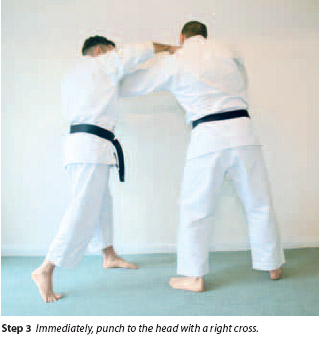
DUCK
Ducking, sometimes called bobbing, is like slipping but instead of moving sideways, you drop down under an attack. It can work against both straight attacks, like a jab or a cross, and against circular attacks like a hook. When ducking, you need to keep your hands up near your head so that you can still block if you time the duck incorrectly. Having your elbows protecting your body and chin will also help to protect you in case something goes wrong and you end up ducking into a knee attack. You also need to make sure that you use your knees to duck rather than bending too much at your waist, so that you can keep an eye on your opponent while you duck and keep your head in a safer position. In boxing, it is more common to bend from the waist mainly because there is no risk of a knee strike in that sport.

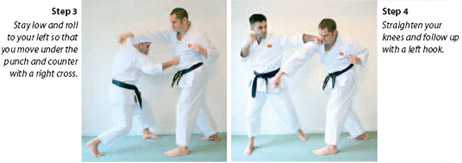
BLOCK AND PARRY
If someone throws a strike at you, be it a punch, a kick, or an elbow, the best way to avoid getting hurt is to get out of the way. Sometimes it just isn't possible to get out of the way of an attack and so you need to use a block or a parry to reduce the damage that the attack will do. A block is a technique that stops an attack dead by getting in the way of it. A parry is subtler in that rather than facing the force of the attack head on, it deflects the attack, redirecting it so that it passes by harmlessly. Blocks are most useful against circular attacks and parries are most useful against straight attacks. If it is a powerful attack, such as an elbow strike, a hook, or a roundhouse kick then this might still hurt you but it is far better to take a big hit on somewhere like your forearm than on your face.
A block can do more than just thwart an attack. A powerful block can be more like an attack to an opponent's arm or leg, and in a self-defense situation this could leave an attacker thinking twice about throwing another punch. A strong parry can redirect an attack in such a way that it can unbalance an attacker leaving them open to a counter attack.
Usually blocks are done with the forearm or the hands, but it is also possible to block using other tough parts of your body such as the shoulders, elbows or knees. Parries can also be done with the forearm but are commonly done using an open hand.
HIGH LEVEL DEFENSE
Use this technique to block a downward or sideways swinging attack at your head. It can also be used as a parry to deflect straight attacks aimed at your head. In karate, this technique is called a rising block, age uke.
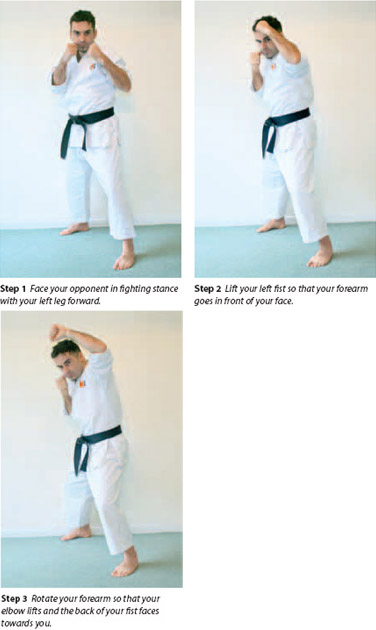
This high block works well when combined with a ducking movement, with your body dropping down while the block sends an attack up over your head.
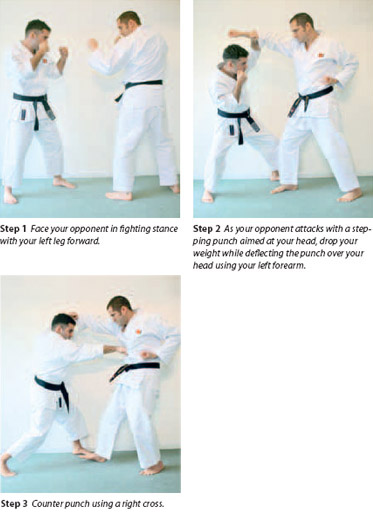
You can increase the effectiveness of this counter attack by reducing the time between the block and the punch. This is especially true if your opponent is moving in towards you as he attacks because then he will be moving into your punch. The ultimate objective of this tactic is to punch at the same time as you block. In Krav Maga, this is known as bursting.
MIDDLE LEVEL DEFENSE FROM THE OUTSIDE
An outside block, called soto uke in karate, can actually be used to parry as well as block and can be used to deflect an attack to the side. Rather confusingly, this block is sometimes referred to as an inside block. To understand this, you need to consider your view when you are fighting. The center of your view is considered the inside and the edges of your view, to the left and right, are considered to be outside. The people who call this technique outside block do so because it approaches from the outside. Those who call it inside block do so because it moves towards the inside.
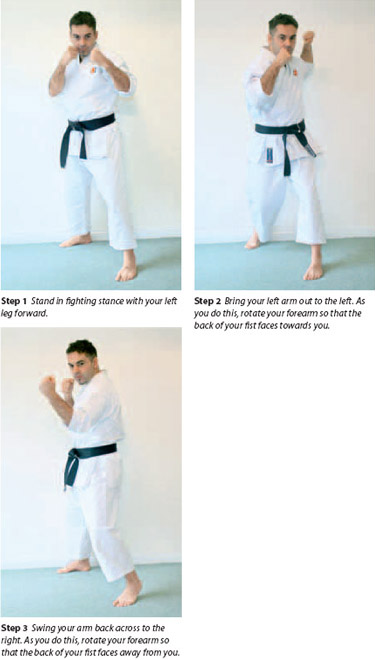
This technique is useful for parrying attacks that are travelling straight into your center, for example, against a stepping punch aimed at your body.
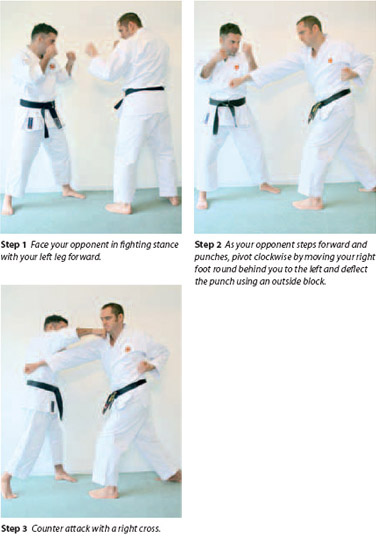
MIDDLE LEVEL DEFENSE FROM THE INSIDE
An inside block, called uchi uke in karate, can be used to block an attack to the side in the opposite direction to an outside block. Again, rather confusingly, this block is sometimes referred to as an outside block. The people who call this technique inside block do so because it approaches from the inside. Those who call it outside block do so because it moves towards the outside.
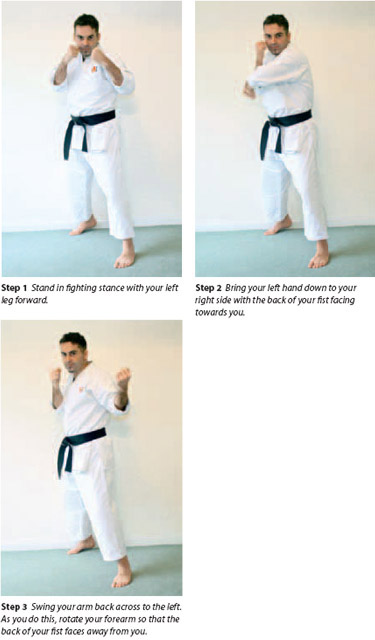
This technique is useful for defending against an attack that is travelling around to hit you from the side, for example, a hooking punch or roundhouse kick.
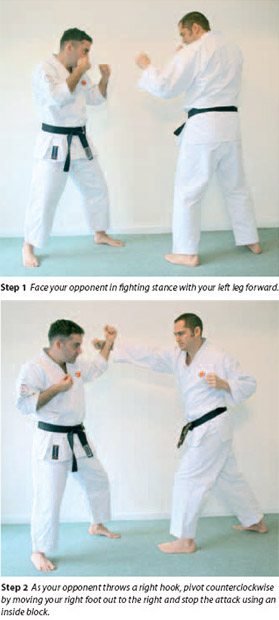
LOW LEVEL DEFENSE
In karate, this block is called a low-level sweep, gedan barai. This technique is most useful when used as a parry to deflect low punches and kicks.
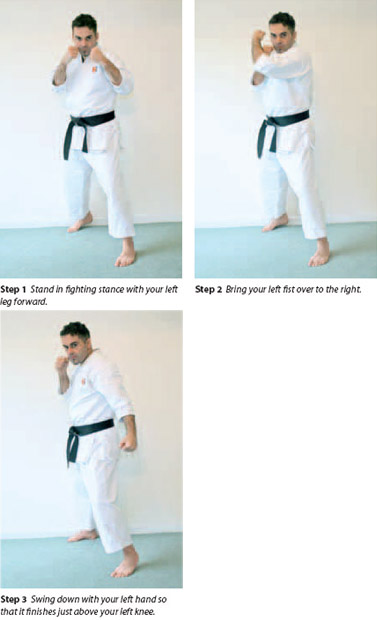
This low level block can be used to parry a front kick. It is important to parry this type of attack rather than block it because an opponent's leg is likely to be stronger than your forearm so a head on collision is likely to injure you. It is better to move out the way of the kick and use your arm to deflect it in the opposite direction. Because of the circular motion of the low level block, it is possible to get your arm underneath your opponent's leg allowing you to unbalance them.
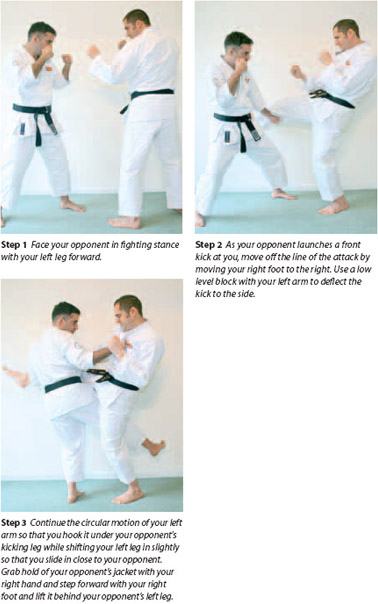

TWO-HANDED DEFENSE
If you are trying to block a really powerful attack such as a hook, a roundhouse kick, or a horizontal elbow strike, sometimes it can be worth using both arms to stop the attack. Using one arm could mean that a strong attack could collapse the defending arm and you could end up with your own fist hitting you in the face. Using two arms pretty much doubles your stopping power. The main drawback of this is that using both arms to block makes it harder for you to counter attack and can leave you open to a follow up attack.
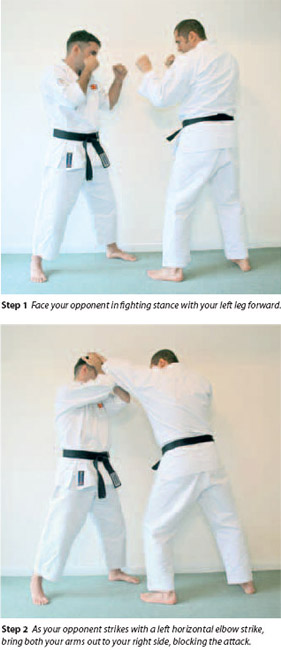
TWO-HANDED CROSS DEFENSE
A cross block, called juji uke in karate, is a type of two handed block that can be used to stop an attack that swings down. It can also be used as a parry to deflect straight attacks aimed at the head.
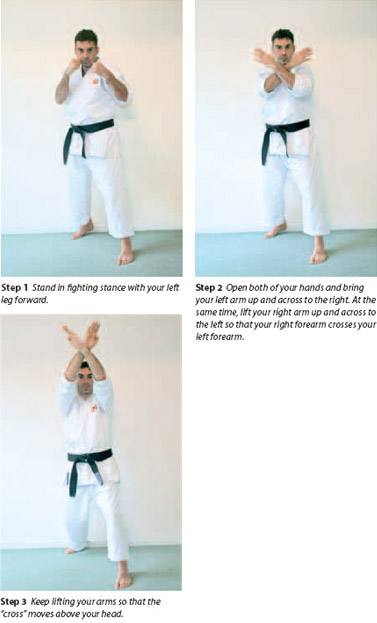
Like all two-handed blocks, this technique's main drawback is that it commits both of your hands, leaving you prone to any follow-up attacks. It therefore should only be used when a dangerous attack absolutely must be stopped. One example would be a stabbing attack with a knife because in this situation the knife represents a serious threat, so it makes more sense to commit everything to stop it.
